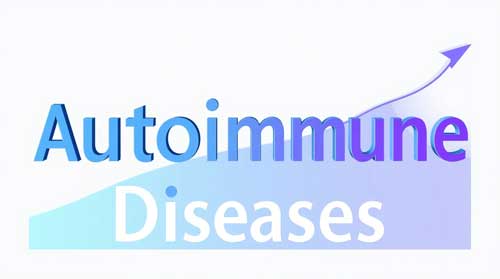Autoimmune Disease Prevalence Hits 5% in US: New Research Reveals Multiple Triggers
Please like and subscribe if you enjoyed this video 🙂
Introduction
Autoimmune diseases now affect approximately 15 million Americans, representing 4.6% of the U.S. population, according to recent research conducted between 2011 and 2022. This important health concern shows an alarming trend, with some studies indicating an annual increase of 3 to 12% in prevalence rates.
The impact of these conditions is notably more pronounced in certain demographics. Women account for 63% of diagnosed cases, making them almost twice as likely as men to develop an autoimmune disorder. Additionally, 34% of affected individuals face the challenge of managing multiple autoimmune conditions simultaneously.
The increasing occurrence of autoimmune disorders is particularly noticeable in certain conditions. Over the past four decades, the number of adults with Type 1 diabetes has doubled, and celiac disease cases have grown five times in the last 30 years. Despite this rise, the exact causes remain complex as researchers explore the interaction between genetic tendencies, environmental influences, and lifestyle changes as possible triggers.
Disease Pattern Changes 2000 to 2024
Longitudinal studies reveal major shifts in autoimmune disease patterns throughout the United States and globally. Antinuclear antibodies (ANA), a key biomarker of autoimmunity, showed a marked increase from 11.0% in 1988 to 1991 to 15.9% in 2011 to 2012. This rise corresponds to an expansion from 22 million to 41 million affected individuals.
Prevalence Increase Timeline
The overall worldwide incidence of autoimmune diseases has risen by 19.1% annually. Specific conditions demonstrate varying growth rates. Throughout 2000 to 2019, substantial increases occurred in:
- Celiac disease (119% increase)
- Sjogren’s syndrome (109% increase)
- Graves’ disease (107% increase)
Additionally, type 1 diabetes cases have shown a consistent 3 to 4% annual increase over three decades. The most concerning trend emerged among adolescents, where ANA prevalence demonstrated a nearly 300% increase between 1988 and 2012.
Geographic Distribution Shifts
Regional variations in autoimmune disease prevalence demonstrate distinct patterns. Specifically, studies identified higher rates in northern latitudes compared to southern regions. The northeastern United States exhibits statistically significant elevated risk, specifically in Vermont, New Hampshire, and southern Maine.
Racial disparities have become apparent across various regions. Studies show major differences in rates among racial groups and geographic locations. For example, African-American rates of systemic lupus erythematosus were highest in the West North Central and South Atlantic areas, while African-American rates of multiple sclerosis were more prevalent in the South Atlantic and Pacific regions.
The socioeconomic gradient across several diseases remains pronounced, with conditions like pernicious anemia showing 72% higher rates in the most deprived areas compared to the least deprived regions. Seasonal variations have also emerged, with childhood-onset type 1 diabetes diagnoses occurring more frequently during winter months.
Lifestyle Factor Assessment
Recent research identifies lifestyle factors as important contributors to autoimmune disease development. Multiple studies demonstrate complex interactions between daily habits and immune system function.
Diet-Related Triggers
The Western dietary pattern shows strong associations with autoimmune conditions. Studies reveal that processed foods contain sodium levels up to 100 times higher than homemade alternatives. This diet pattern affects gut health through multiple mechanisms:
Processed foods damage epithelial barrier function
High-fat consumption promotes systemic inflammation
Insufficient dietary fiber deprives gut microbiota
Ultra-processed foods contribute to intestinal dysbiosis
Sleep Pattern Effects
Sleep deprivation plays a crucial role in regulating the immune system. Studies show that adults who get less than six hours of sleep per night have a higher risk of developing autoimmune diseases. A comprehensive study conducted in Taiwan revealed that people with sleep disorders unrelated to apnea had a 70% greater likelihood of acquiring autoimmune conditions. Additionally, ongoing sleep loss fosters a pro-inflammatory state, increasing tumor necrosis factor and interleukin-6 levels.
Stress Level Correlations
Psychological stress has a major influence on the development of autoimmune diseases. A retrospective cohort study from Sweden found that disorders related to stress elevate the risk of subsequent autoimmune diseases. Veterans with post-traumatic stress disorder are at double the risk of developing systemic autoimmune diseases. As a result, psychiatric responses to life stressors can disrupt immune function by affecting the hypothalamic-pituitary-adrenal axis. Research indicates that treating PTSD patients with SSRIs can lower the heightened risk of autoimmune conditions.
Genetic Risk Evaluation
Genetic studies reveal complex inheritance patterns in autoimmune disease development. Twin studies demonstrate disease concordance rates 4 times higher in monozygotic twins compared to dizygotic twins. Nevertheless, the incomplete concordance in identical twins indicates that additional factors influence disease manifestation.
Hereditary Pattern Analysis
Family association studies indicate strong familial connections, with odds ratios ranging from 5 to 10 for multiple sclerosis, type I diabetes, and Graves disease. Genome-wide association studies (GWAS) have identified hundreds of genetic polymorphisms linked to increased autoimmune disease risk. Primarily, these variants affect genes that regulate B-cell proliferation, differentiation, and activation.
Three main gene groups raise autoimmune disease risk:
- T cell receptor genes
- Immunoglobulin genes
- Major histocompatibility complex genes
Gene-Environment Interactions
Although genetic predisposition plays a crucial role, environmental factors considerably influence disease expression. DNA methylation patterns change in response to environmental triggers, essentially altering gene expression without modifying DNA sequences. The Epstein-Barr Virus, rather than remaining dormant after childhood infection, interacts with genetic variants to trigger systemic lupus erythematosus, rheumatoid arthritis, and Sjogren’s syndrome.
Research indicates that toxicants represent a distinct category of gene-environment interactions. These interactions operate bidirectionally – environmental factors can cause somatic mutations, hence altering genotype, while inherited genetic variants affect toxicant metabolism. Furthermore, both outdoor and indoor air pollution interact with genetic variants to increase disease risk. The worldwide pollution crisis continues to impact human health through these genetic mechanisms.
Prevention Strategy Development
Prevention strategies for autoimmune diseases focus on modifiable risk factors, given that approximately 40% of cases stem from lifestyle-related triggers. Medical professionals now approach these conditions as potentially preventable, similar to cardiovascular disease.
Risk Factor Modification
Primary prevention efforts target key environmental and lifestyle factors. A Mediterranean diet rich in vegetables, fruits, olive oil, and whole grains reduces inflammation markers. Physical activity, primarily 20 to 30 minutes of daily exercise, coupled with vitamin D maintenance, shows promising results in disease prevention.
Key preventive measures include:
- Smoking cessation and protection from occupational exposures
- Maintaining optimal vitamin D levels
- Regular dental hygiene to prevent periodontal disease
- Reducing exposure to environmental toxins
Population Screening Programs
Screening initiatives primarily target high-risk populations. The Autoimmunity Screening for Kids (ASK) initiative has evaluated 28,549 children, finding that 3.25% have autoantibodies for type 1 diabetes and 2.7% show markers for celiac disease. It is important to note that these programs employ sophisticated testing techniques, like electrochemiluminescence detection, which enhance the sensitivity of early detection.
Thanks to recent advancements in therapies that modify diseases, screening programs on a large scale can now identify individuals at risk before symptoms appear. For instance, birth cohort studies such as TEDDY track over 8,000 newborns with genetic risk factors for 15 years, recording environmental influences that contribute to the development of diseases.
Early Intervention Protocols
Early intervention approaches demonstrate notable promise in altering disease trajectories. Research indicates that optimal treatment windows extend into asymptomatic preclinical phases. As a result, medical professionals now focus on identifying and treating conditions before clinical manifestation.
The Type 1 Diabetes Prediction and Prevention Study has screened more than 250,000 infants since 1994, monitoring those at risk until age 15. This approach enables early detection and intervention, potentially reducing the need for lifelong medication. Monitoring protocols typically include regular antibody testing and assessment of environmental exposures.

Conclusion
Autoimmune diseases represent a major healthcare challenge, affecting 15 million Americans with an annual increase of 3 to 12% in prevalence rates. Research demonstrates complex interactions between genetic predisposition, environmental triggers, and lifestyle factors driving this surge. Specifically, diet choices, sleep patterns, and stress levels emerge as crucial modifiable risk factors.
Medical evidence points to promising prevention strategies through targeted interventions. Population screening programs successfully identify at-risk individuals before symptom onset, while early intervention protocols show potential in altering disease trajectories. Additionally, genetic studies reveal important hereditary patterns, though environmental factors substantially influence disease expression.
Healthcare professionals now approach autoimmune conditions as potentially preventable diseases, similar to cardiovascular disorders. This paradigm shift, supported by extensive research on modifiable risk factors, opens new possibilities for disease prevention and management. The combination of genetic screening, lifestyle modifications, and early intervention protocols offers hope for reducing the burden of autoimmune diseases in future generations.
Frequently Asked Questions:
Q1. What is the current prevalence of autoimmune diseases in the United States?
Recent research indicates that approximately 15 million Americans, or 4.6% of the U.S. population, have been diagnosed with at least one autoimmune disease. The prevalence is increasing annually by 3 to 12%.
Q2. Why are women more likely to develop autoimmune diseases?
Women account for 63% of diagnosed autoimmune disease cases, making them almost twice as likely as men to develop these conditions. While the exact reasons are not fully understood, genetic and hormonal factors are believed to play a role.
Q3. What lifestyle factors contribute to the development of autoimmune diseases?
Key lifestyle factors include diet (particularly processed foods high in sodium), sleep patterns (with less than 6 hours of sleep increasing risk), and stress levels. These factors can influence gut health, inflammation, and overall immune system function.
Q4. How do genetic and environmental factors interact in autoimmune disease development?
While genetic predisposition is important, environmental factors have a major influence on disease expression. DNA methylation patterns can change in response to environmental triggers, altering gene expression. Factors like viral infections and toxicants can interact with genetic variants to increase disease risk.
Q5. What prevention strategies are being developed for autoimmune diseases?
Prevention strategies focus on modifying risk factors through lifestyle changes, such as adopting a Mediterranean diet and regular exercise. Population screening programs are being implemented to identify high-risk individuals before symptom onset, and early intervention protocols are being developed to potentially alter disease trajectories.





